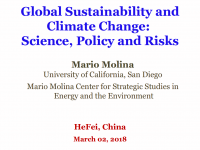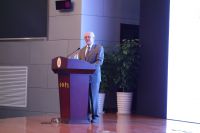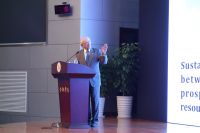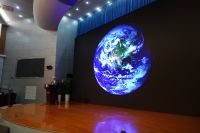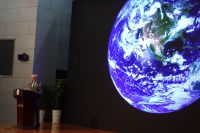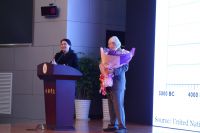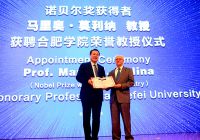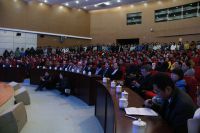Today, the Nobel laureat Prof. Mario J. Molina visited our Hefei University [合肥学院] and gave the talk "Global Sustainability and Climate Change: Science, Policy and Risks" in our library, just across our institute's building. Prof. Molina is one of the world's leading experts on climate and sustainability. He is professor at University of California, San Diego and the Center for Atmospheric Sciences at the Scripps Institution of Oceanography. He received a Nobel Prize in chemistry for his research on the impact of CFC on the ozon layer and was one of the consultants advising the Obama administration in climate issues. Today, he was awarded the honorary professor title of our university. Here, I want to summarize his highly interesting talk on the challenges we face when trying to achieve sustainability, i.e., an economy and way of life which does not threat the well-being of future generations.
Introduction
Prof. Molina started his talk with a quotation from the Brundtland Commission in 1983: "Sustainable development is development that meets the needs of the present without compromising the ability of future generations to meet their own needs." This goal aims to harmonize human development with nature.
The Situation
However, human development has undergone a great acceleration during the last 50 to 100 years, with an exponential increase of population size, economical affluence, and available technologies (e.g., patents). Regardless of at which measure of human activity we look, say the total population, the global GDP, the foreign direct investment, the urban population, the primary energy use, the fertilizer consumption, the number of large dams, the water use, the paper production, the number of motor vehicles, the number of people with telecommunication subscriptions, or the international tourism — all have at least more than doubled since the 1950s. This cannot go without impact on the environment, which actually is so huge that researchers propose that we are now living in a new geological epoch, called the anthropocene.
The Safe Operating Space
Researchers looking for a "safe operating space" for the human population have identified three areas where we are already outside of any safe limit: climate change due to greenhouse gases emitted due to human activities, biodiversity loss due to human-caused extinctions, and the nitrogene cycle, due to the use of fertilizer. For several other fields, such as atomospheric aerosol loading and chemical pollution, scientists simply don't know yet the acceptable boundaries, so they cannot state whether we are in the safe zone or not. We are currently most likely operating reasonable in terms of, e.g., land and fresh water use and oceanic acidification. The only field where the human civilization as a whole, by finding a consensus and establishing global rules and implementing, managed to return to the safe zone after leaving it is the global ozone depletion — to which the work of Prof. Molina has contributed. Nevertheless, humans still continue to damage the environment, e.g., by deforestation or by excess fertilizer use leading to dead zones in costal ocean regions.
Climate Change
Prof. Molina then focuses on climate change. He first debunks three myths, namely
- Although some people may think that there is no scientific consensus on climate change, the vast majority of researchers (over 97%) today believe that climate change is happening and is caused by greenhouse gas emmission.
- Although some people might think that the climate change will take place at the end of the century, if at all, and not affect them, it is already taking place now. The earth's temperature is already 1°C above what it should be, most likely due to the impact of our civilization, and natural desasters have become much more powerful, leading to higher costs both in lifes and capital.
- Although some people may think that regulating fossil fuels would be to costly, new technologies have already become competitive — and climate change itself would also impose tremendous costs.
Global Actions
Several global actions have already taken place to limit climate change. These include, e.g., the Copenhagen Accord in 2009, where the goal of limiting the global temperature increase to 2°C was defined. Prof. Molina lists actions needed to achieve this, including to put a price on carbon emissions, to increase investments in energy-technology research and development, and to expand international cooperation on deploying these technologies. The Paris Agreement in 2015 then established credible reporting and transparency requirements and provided financial measures. It also stipulates to negotiation periodically on the topic, e.g., every 5 years. The IPCC Fifth Assessment Report provides a physical foundation for policymakers and shows that without limiting emissions and implementing the existing agreements, it would be extremly unlikely to limit global warming.
Of course, science is not fortune telling, nobody can know what exactly will happen in the future if do or not do a certain thing. But scientistics can give very exact predictions of how likely certain events are, based on our current knowledge. Without any emission policy, they expect an almost 25% chance that the temperature may increase by at least 6°C and only a chance of below 15% that the increase may be limited to 3 or 4°C. Such increases would be devastating. Limiting the total CO2 in the atmosphere to at most 550ppm would give an almost 100% chance to limit the temperature increase to at most 4°C and more than 50% chance to keep it at at most 2.5°C.
The Stern review concludes that the cost of climate change will exceed our past expectations and that the existing models were not sufficient to predict its impact on the global economy.
Conclusion
It may be true that the current US administration may not focus on climate change or consider undoing some previous advances. Yet, on state level and below, there exist a very high activity to improve sustainability and to fight global waming. Prof. Molina concludes that we must strive for a sustainable living and economy. Do anything else would be completely immoral and doom our children. And, at least in banning CFCs globally, humanity has shown that it is able to achieve global agreement and regulations, for the sake of all of us.
Photos
The Relationship to Optimization
There is actually nothing to add to this excellent talk. Of course, I, as a researcher working on computational intelligence, look at the topic from the perspective of my field. I think that all of these topics are very closely related to optimization. Technical innovations, such as new materials, better ways to gain energy or clean water, all can substantionally reduce resource consumption or pollution. Optimization and operations research, on the other hand, help to make the best out whatever technology we have. By better planning how to use resources and by making our logistics smarter, we could already decrease pollution, waste, and resource consumption very significantly. Optimization is thus not just an essential component of smart manufacturing, but can complement research in new. environmentally friendly technologies and sustainability.



